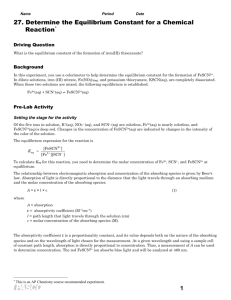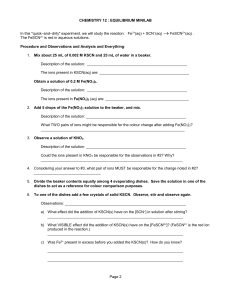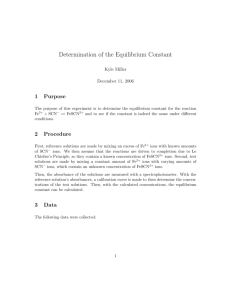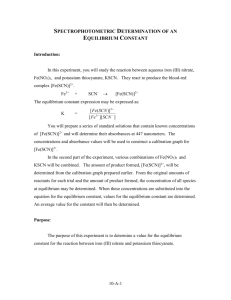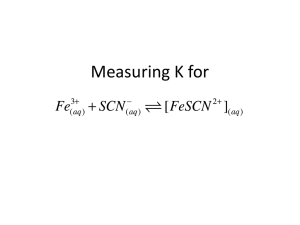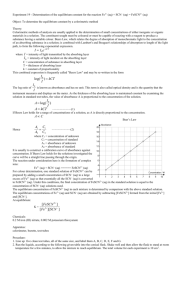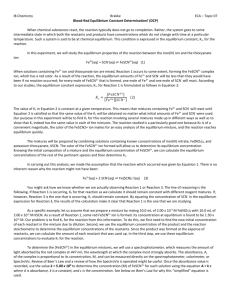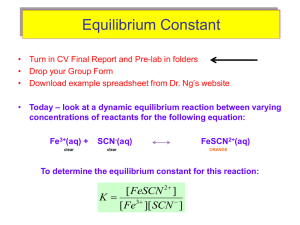Experiment 3 Measurement of an Equilibrium Constant
advertisement
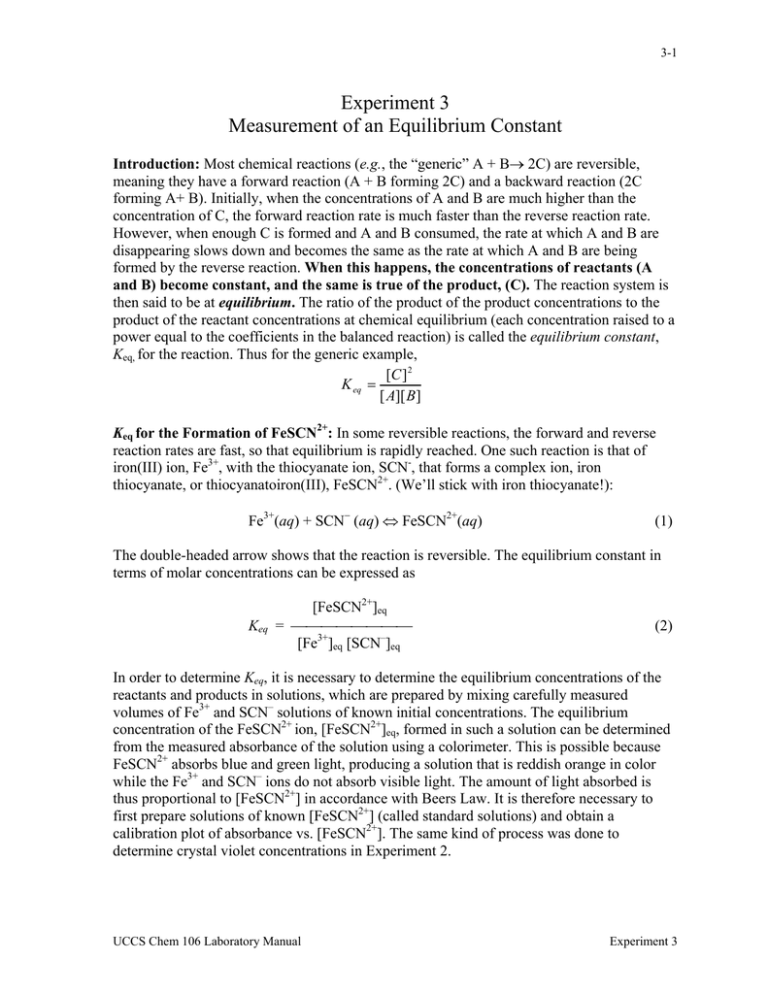
3-1 Experiment 3 Measurement of an Equilibrium Constant Introduction: Most chemical reactions (e.g., the “generic” A + B→ 2C) are reversible, meaning they have a forward reaction (A + B forming 2C) and a backward reaction (2C forming A+ B). Initially, when the concentrations of A and B are much higher than the concentration of C, the forward reaction rate is much faster than the reverse reaction rate. However, when enough C is formed and A and B consumed, the rate at which A and B are disappearing slows down and becomes the same as the rate at which A and B are being formed by the reverse reaction. When this happens, the concentrations of reactants (A and B) become constant, and the same is true of the product, (C). The reaction system is then said to be at equilibrium. The ratio of the product of the product concentrations to the product of the reactant concentrations at chemical equilibrium (each concentration raised to a power equal to the coefficients in the balanced reaction) is called the equilibrium constant, Keq, for the reaction. Thus for the generic example, [C ] 2 K eq = [ A][ B] Keq for the Formation of FeSCN2+: In some reversible reactions, the forward and reverse reaction rates are fast, so that equilibrium is rapidly reached. One such reaction is that of iron(III) ion, Fe3+, with the thiocyanate ion, SCN-, that forms a complex ion, iron thiocyanate, or thiocyanatoiron(III), FeSCN2+. (We’ll stick with iron thiocyanate!): Fe3+(aq) + SCN− (aq) ⇔ FeSCN2+(aq) (1) The double-headed arrow shows that the reaction is reversible. The equilibrium constant in terms of molar concentrations can be expressed as Keq [FeSCN2+]eq = ⎯⎯⎯⎯⎯⎯⎯⎯ [Fe3+]eq [SCN–]eq (2) In order to determine Keq, it is necessary to determine the equilibrium concentrations of the reactants and products in solutions, which are prepared by mixing carefully measured volumes of Fe3+ and SCN– solutions of known initial concentrations. The equilibrium concentration of the FeSCN2+ ion, [FeSCN2+]eq, formed in such a solution can be determined from the measured absorbance of the solution using a colorimeter. This is possible because FeSCN2+ absorbs blue and green light, producing a solution that is reddish orange in color while the Fe3+ and SCN– ions do not absorb visible light. The amount of light absorbed is thus proportional to [FeSCN2+] in accordance with Beers Law. It is therefore necessary to first prepare solutions of known [FeSCN2+] (called standard solutions) and obtain a calibration plot of absorbance vs. [FeSCN2+]. The same kind of process was done to determine crystal violet concentrations in Experiment 2. UCCS Chem 106 Laboratory Manual Experiment 3 3-2 Preparation of Standard Solutions: To get solutions with known [FeSCN2+], the following process will be used. You will prepare standard solutions by mixing carefully measured volumes of solutions of Fe3+ (using FeNO3 stock solution) and SCN– (using KSCN stock solution) of known concentrations. These volumes for standard solutions A-F are listed in the Standard Solutions Table in Part A step 7. The key to getting a known concentration of FeSCN2+ in each of these solutions is that the initial concentration of Fe3+ is much greater than the initial concentration of SCN– ion. When the Fe3+ concentration is in large excess, the equilibrium will shift (according to LeChatelier’s Principle) to the product side until virtually all the SCN– is converted to FeSCN2+. Thus the equilibrium concentration of FeSCN2+ in a standard solution will be virtually the same as the initial concentration of SCN– in the solution. This initial value, [SCN–] initial, which equals [FeSCN2+] in the mixed standard solution, can be calculated from the volume and molarity of the SCN– stock solution (mol SCN– = MxV) and the final total volume (in L) of the mixed standard solution. With these calculated values for [FeSCN2+] and the measured absorbances of these standard solutions, a Beers Law plot can be obtained. Calculation of Keq from [FeSCN2+]eq, [Fe3+]eq and [SCN–]eq : A series of sample solutions can then be made up from varying combinations of the reactant solutions as shown in the Sample Solutions Table in Part B, Step 5. Once the equilibrium concentration of FeSCN2+ is determined in these solutions using the measured absorbances and the Beers Law plot, it is an easy matter to determine the equilibrium concentrations of the other reactant species. This is because as equation (1) shows, for every one FeSCN2+ produced, one Fe3+ ion is used up. Thus the concentration of Fe3+ that remains at equilibrium is the initial concentration of Fe3+ minus the concentration of Fe3+ that formed product, which is the same as [FeSCN2+]eq. The equilibrium concentrations of Fe3+ and for the same reasons, SCN– can thus be expressed as [Fe3+]eq = [Fe3+]initial – [FeSCN2+]eq (3) [SCN–]eq = [SCN–]initial – [FeSCN2+]eq (4) These concentrations are then used to determine Keq from equation (2). An ICE (Initial, Change, Equilibrium) table can also be used to relate [FeSCN2+]eq to the equilibrium concentrations of the reactants. For example, given [Fe3+]initial = 0.00100 M, and [SCN–]initial = 0.00020 M, and an equilibrium concentration, [FeSCN2+]eq = 0.0000195 M, the ICE table will be: Initial Change Equilibrium Fe3+ + SCN− ⇔ FeSCN2+ 0.00100 0.00020 0 -0.0000195 -0.0000195 + 0.0000195 0.00098 0.00018 0.0000195 The initial concentration of FeSCN2+ is zero because the reaction has not yet started, but at equilibrium its concentration, as measured from the absorbance, is 0.0000195 M. This equates to a change of + 0.0000195 M in the FeSCN2+. From the balanced reaction, if 0.0000195 M is gained on the product side, it must have been lost from the reactants. UCCS Chem 106 Laboratory Manual Experiment 3 3-3 Therefore, the equilibrium concentrations of the reactants are their initial concentrations less the equilibrium concentration of the FeSCN2+. For this example, the equilibrium constant would be 1.1×102 as shown in the following calculation. K eq = [0.0000195 ] = 1.1 × 10 2 [0.00098][0.00018] Consult your textbook to see why Keq does not have units. In this experiment you will determine Keq for reaction (1) by obtaining a Beers Law plot for FeSCN2+ and using the plot to calculate [FeSCN2+]eq in sample solutions from absorbance measurements. Pre-Lab Notebook: Provide a title, purpose, reaction(s), summary of the procedure, and a table of reagents, Fe(NO3)3, KSCN, and HNO3. Create the Part A and Part B Data Tables shown below. Use the values in the Standard Solutions Table in Part A and the Sample Solutions Table in Part B to calculate the values of concentration in the shaded areas of the Data Tables. Then enter these values into the tables before coming to lab. Recall that the molarity of an ion in the mixed solutions is given by (MxV of stock solution / total mixed solution volume in L). Also note that the [FeSCN2+] in the Part A Data Table is obtained by calculating the [SCN–]initial as discussed in the section above on “Preparation of Standard Solutions.” To avoid a common student error, note that the concentration of Fe(NO3)3 in Part A is 0.200 M, while in Part B, it is 2.00 x 10−3 M. Part A: Data Table (Standards) Part B: Data Table (Samples) [FeSCN2+] Beaker [Fe3+]initial [SCN–]initial Flask Abs A B C D E F Abs [FeSCN2+]eq 1 2 3 4 5 Equipment: Stock Solutions: 100 mL (or 150 mL) Beakers (5) 0.200 M Fe(NO3)3 50 mL Volumetric flasks (6) 2.00 x 10-3 M Fe(NO3)3 50 mL Beakers (2) 2.00 x 10-3 M KSCN Buret 0.5 M HNO3 Ring stand, buret clamp 10.0 mL Graduated pipets (2) and pipet bulb 400 mL Beaker (for waste) Vernier equipment and colorimeter In-Lab Experimental Procedure: Note: Work in pairs. Volumetric measurements must be accurate, so measure all of the solutions carefully and rinse the pipets and buret with the appropriate stock solutions before use. UCCS Chem 106 Laboratory Manual Experiment 3 3-4 Part A: Standard Solutions and Calibration Curve 1. Set up the Vernier system in DATAMATE as in Experiment 2 and turn on the colorimeter, allow it to warm up (at least 5 minutes) while the standard solutions are prepared. 2. Set the wavelength on the colorimeter to 470 nm using < > arrows on colorimeter. 3. Label six 50 mL volumetric flasks, A–F, for the standard solutions. 4. Use a labeled (with tape)10.0 mL graduated pipet for transferring KSCN and a buret for transferring Fe(NO3)3. 5. Measure 12.50 mL of 0.200 M Fe(NO3)3 into each flask with the buret (if you overshoot this amount you must start again). 6. Pipet amounts of KSCN to each flask according to the following table. 7. Use a clean 50 mL beaker to fill each flask close to the 50.00 mL mark with 0.5 M HNO3. Use an eyedropper or disposable pipet to bring the volume to precisely the 50.0 mL mark. Then use a parafilm square to close off the top of the flask and invert a few times to insure thorough mixing. Standard Solutions Table: *The volume of 0.50 M nitric acid does not need to be measured, just fill to the mark after carefully measuring and adding the first two solutions. Standard Solutions A B C D E F Total Volume 50.00 mL 50.00 mL 50.00 mL 50.00 mL 50.00 mL 50.00 mL Volume of KSCN Solution 0.50 mL 1.00 mL 2.00 mL 3.00 mL 4.00 mL 5.00 mL Volume of 0.200 M Fe(NO3)3 Solution 12.50 mL 12.50mL 12.50 mL 12.50 mL 12.50 mL 12.50 mL Volume of 0.5 M HNO3* 37.00 mL 36.50 mL 35.50 mL 34.50 mL 33.50 mL 32.50 mL 8. Set the data collection mode: On the main screen of the DATAMATE program, go to SETUP and move the cursor until it’s to the left of the mode selection and press ENTER. Change the mode to 3. EVENTS WITH ENTRY, and then get back to the main screen of DATAMATE 9. After warm up, or at any time during the experiment, calibrate the colorimeter by filling the cuvette with de-ionized water and pushing the CAL button on the colorimeter. The LEDs will flash several times and the new absorbance should read 0 or .001. Note: the plastic cuvettes have one set of opposite sides with ridges designed for holding the cuvette, and a clear set of sides that should line up with the arrow inside the colorimeter. Always put the cuvette in the colorimeter in the correct orientation. 10. From the main screen, select “2” for START to begin data collection. 11. Remove and empty the cuvette with the de-ionized water. (Tip: It is easier to pour solution into the cuvette from a beaker than from a volumetric flask.) Transfer about 20 mL of solution A into a clean 50 mL beaker, and from the beaker, add solution A to rinse the cuvette. Then fill the cuvette three-fourths full, and wipe the outside clear sides of the cuvette. Place the cuvette inside the colorimeter and close the lid UCCS Chem 106 Laboratory Manual Experiment 3 3-5 immediately. Allow 15 seconds for the absorbance reading to stabilize, record it in your Part A data table, and press ENTER to store the reading. 12. The Vernier system will prompt you to enter the concentration of the solution. After entering the concentration, [FeSCN2+], you calculated for solution A, press ENTER . 13. Measure and record the absorbance of the rest of the standard solutions B – F using the same procedure, making sure to rinse the cuvette with each solution prior to the measurement. 14. After the final absorbance has been measured, click the STO> button to stop data collection. To exit the program press the ENTER key. 15. Select “6” for QUIT from the main screen. Then press ENTER on the screen that indicates your data location. 16. Transfer this data to the Logger Pro computer program, cut and paste the columns of data into Microsoft Excel and save the file, make a line graph with the data and add a linear trendline. Print the calibration curve and have it initialed by your Instructor. Part B: Equilibrium Mixtures and Equilibrium Constant 1. Label (with tape) five 150 mL beakers, 1–5, for the equilibrium sample mixtures. 2. To prepare the sample solutions, use the same previously labeled 10.0 mL graduated pipet for transferring KSCN and a separate labeled 10.0 mL graduated pipet for transferring the HNO3. 3. Rinse the buret with DI water and then about 10 mL of the 2.00 × 10-3 M Fe(NO3)3. Then use the buret to transfer 10.00 mL of the 2.00 × 10-3 M Fe(NO3)3 into each beaker for the equilibrium sample solutions. 4. Carefully pipet the appropriate amounts of KSCN and HNO3 into each beaker, according to the Sample Solutions Table below. 5. Swirl each beaker to mix the solutions. Sample Solutions Table: Equilibrium Solutions 1 2 3 4 5 Total Volume 20.00 mL 20.00 mL 20.00 mL 20.00 mL 20.00 mL Volume of 2.00 × 10–3 M Fe(NO3)3 10.00 mL 10.00 mL 10.00 mL 10.00 mL 10.00 mL Volume of KSCN Solution 2.00 mL 4.00 mL 6.00 mL 8.00 mL 10.00 mL Volume of 0.5 M HNO3 8.00 mL 6.00 mL 4.00 mL 2.00 mL 0.00 mL 6. Recalibrate the colorimeter using DI water. However you will not need to set up in a data collection mode. 7. In the Part B Data Table, measure and record the absorbance of the equilibrium solutions, 1 – 5, reading directly from the calculator output. Start with the most dilute solution first, rinsing the cuvette with each solution prior to the measurement. 8. After the final absorbance has been measured, select 6 for QUIT and return the Vernier system to its containers. UCCS Chem 106 Laboratory Manual Experiment 3 3-6 Lab Report Outline for Equilibrium Constant Graded Sections of Report Percent of Grade Pre-Lab 10 In-Lab Part A table: 10 Part B table: 10 Post-Lab (You will save considerable time and effort by using Excel to carry out your calculations and plotting. But in your lab notebook post-lab section, show required sample calculations, being sure to number each step.) Part A: Calibration Curve: 1. Show a sample calculation of [FeSCN2+] for standard solution A. 2. Attach an Excel spreadsheet giving the table of data from LoggerPro and the clearly labeled chart of the Beers Law plot showing the equation of the line and a trendline. 4 10 Part B: Equilibrium Solutions (Show sample calculations for Sample 1.) 1. Calculate the [FeSCN2+]eq using the equation of the line from the Beers Law plot. 8 2. Calculate [Fe3+]eq and [SCN–]eq using equations (3) and (4). 8 3. Calculate Keq using equation (2). 10 4. Attach a table (preferably from Excel) showing the calculation of the average of the Keq values for sample solutions 1-5 and state, “The mean value of Keq is __________.” 20 Discussion: Summarize what you accomplished. Problems with experimental procedure? Sources of error? 10 UCCS Chem 106 Laboratory Manual Experiment 3
